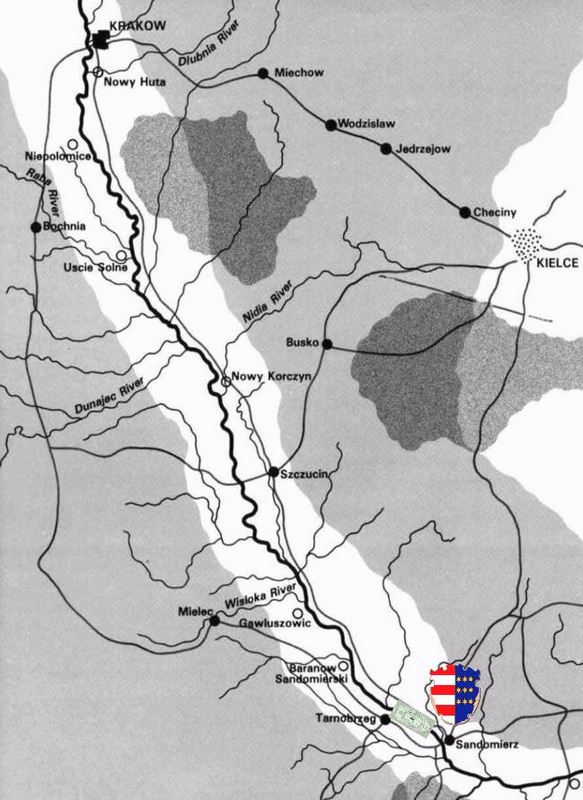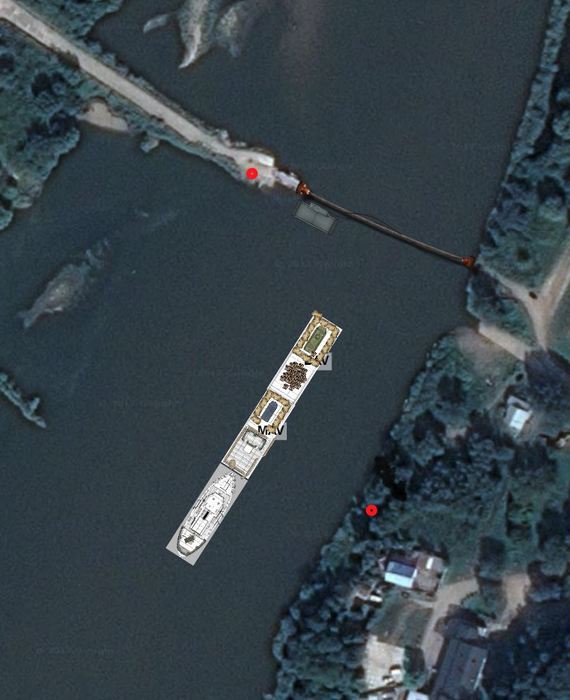26 Aug 2000
The Visla Krolowa, pushing her long barge, embarked at first light. Adam warned all aboard that the Vistula River was not the same as it had been before the war. Without regular maintenance and dredging, there would be many hazards to navigation. And there would be man-made hazards as well, he warned on a somber note. Adam had lost his last tug, the Rzeka Ksiezna – and nearly his life – trying to make this same trip downriver last Spring.
Pirates of the Vistula. Tug info, river conditions, settlements along the way, and riverine encounters.
1985 … William H. Keith, Jr. 40 pages + centerfold charts/map … GDW 502
Sgt. William [played by my younger son] volunteered to take river hazard watch duty. Adam warned him it would be difficult and tedious. From the very front of the barge, William was to observe the river. Adam described sandbars, mud shoals, wreckage, rocks, snags, and sawyers (snags freely bobbing up and down). The Vistula, this far upstream, averaged only 3 meters in depth, and often much less.
Maks detailed others to watch the shore line and elsewhere, since William would be so focused on the river.

At Uscie Solne, where the Raba River fed into the Vistula, William missed a mud shoal. The barge grounded, and it took 4 hours to get unstuck. A lesson was learned, and William noted that at the junction of smaller rivers, the Vistula would have a lot of silt and debris in the path of their tug.
They continued until dark. The shoreline and river was eerily quiet. No boats, no people. Adam was ill at ease, as this part of the river had been a pleasant part of his travels last spring.
William was spotting hazards like a pro now, keeping the Krolowa and her barge out of harm’s way. The bridge at Szczucin presented a different kind of challenge.
The Szczucin – Tarnow road crosses the Vistula over a steel trestle bridge which, before the war, cleared the river at its normal level by a good 10 meters. At some point the bridge was damaged, possibly by partisans, possibly by military traffic too heavy for the ancient span. The north bridge pylons have collapsed, dropping that end of the bridge to within a few meters of the river.
With sandbars and rocks visible on the south side of the river, the Krolowa was forced to squeeze under the fallen bridge between where it drops too low for passage and the edge of the shoal water.
Even after taking down the mast and cargo boom, it was a tight fit. The tug got hung up underneath, causing the bridge to vibrate, and ominous groaning sounds echoed across the river. The Krolowa jerked free, and continued on its way.
They spent the night near the junction of the Wisloka River, anchored to a sandbar in the middle of the river. Maks ordered light and sound discipline. The night passed without incident.
27 Aug 2000
The next morning, they pushed off, continuing south and east, downriver. Very soon, they passed Gawluszowice. Old Adam remembered Gawluszowice as a friendly village of farmers who welcomed him on his last trip and sold him food and a couple of bottles of wine.
Now, it was a literal graveyard as they passed. Through binoculars, they noted the buildings in disrepair. A skeleton in rags was sitting against a house wall.
Disquieted, they proceeded downriver. At Baranów Sandomierski, they had their first encounter. Ahead was a rowboat with three onboard. They seemed intent on the south shore, and didn’t notice the tug and barge at first. As the group closed the gap, the people in the rowboat were startled, and began rowing furiously towards shore. Through binoculars, the middle man could be seen tied up. The two rowers had AKs propped next to them.

It became a pursuit. Though the tug and barge vastly outmassed the rowboat, they were under steam power, and closed the gap quickly. The man in the middle, despite being having his hands tied, leaped overboard. Maks – an expert swimmer – ran down the length of the barge and dived in the water.
The two men in the rowboat paddled for shore, counting on the distraction. William aiming to put a shot across their bow with his sniper rifle, missed badly, and instead the round went through their boat wall. Áron, quickly thinking, shouted “Halt!” in Russian. Both rowers involuntarily turned their heads at the call, but resumed rowing. They reached shore, and ran away through the mud and trees out of sight.
The man in the water, rescued, was Lec Kolzny. He spoke native Polish, and said he was a resident of Baranów Sandomierski. The town had been wiped out by Russian marauders, the few survivors camping a distance away. The man was clearly conflicted, weighing his distrust of the newcomers with the odds of completing his mission alone. He relented.
The people of Baranów Sandomierski had fought the marauders in a vicious delaying action, buying time for their people to escape. They also had a valuable stash of gasoline and other supplies nearby. The marauders, exhausted and depleted from the fight, hadn’t found the cache. Recently, however, word had gotten out about the existence of the supplies. Kolzny was caught, and the two Russians were attempting to coerce its location from him.
Kolzny offerred to split the cache with the party if they’d escort him. Maks, now concerned about the two Russians reporting back, and hearing from the man that the marauders held the nearby town of Tarnobrzeg in terrorized captivity, decided to push ahead promptly. If they delayed, the marauders could be waiting with overwhelming force. They would return for the cache later by vehicle.
There was a complication. Adam reported that the citizens of Tarnobrzeg had rigged a makeshift cable across the water in service of a ferry. It could block their passage. The cable could be disconnected from either shore, allowed to settle into the river, and be retrieved by an attached rope.
With the city reportedly in the hands of marauders, they must assume the ferry line would be manned. Adam felt that the Krolowa and her barge had enough mass and power to bull their way through if necessary, but couldn’t be sure. Wojciech rigged up an improvised explosive that could be draped over the cable if necessary.
As the Krolowa approached, the river narrowed considerably. A spit of land extended well into the river, and from there the ferry system crossed the narrow gap. Activity could be seen both at the peninsula, and in the woods on the south shore. The crew and party took cover. Machineguns opened up from both locations, stitching the tug and barge with bursts. The Krolowa returned fire with both port and starboard DShKs, and small arms.
This gunfire exchange continued for several turns. The Krolowa and her barge were easy to target, but much of their structures weren’t particularly vulnerable to small arms fire. The bridge was hit, however, igniting a small fire there.

The machinegun nests were frustratingly difficult to silence. The Krolowa’s barge contacted the cable, and strained it. Adam increased engine power.
A mortar from somewhere onshore started dropping rounds on the tug. The first shell impacted the river well away from the boat.
Finally the machinegunners on shore were taken out, one by one. The massive posts on each shore shrieked, and the cable was taut as a fiddle. From the front of the barge, Wojciech ground his teeth and gingerly laid the explosives over the cable, ignited the fuse, and took cover deep in the barge.
A mortar round impacted in the water just off the tug’s port bow, rocking the boat. Far ahead, the explosive detonated, severing the cable. The tug and barge lurched forward. The mortar attempted two more shots, but a moving boat was nigh-impossible to target.
They made their way to Sandomierz, which was told to be an open city, much like a smaller version of Krakow.
After-action report
The bridge fire was quickly extinguished.
The tug’s starboard fresh water tank was holed by machinegun fire. A minor repair.
More seriously, the mortar’s near miss on the Krolowa buckled the port bow hull plating under the waterline. The tug is taking on water, just a bit more than the automatic pumps can handle, requiring crew members to man the manual pumps 20 minutes out of every hour.
(The barge also took damage at the front from ramming the cable, and the explosion. But remarkably does not require repairs.)
The Krolowa can be beached on shore, and the crew can use gear from the machine shop to repair the hull damage. It requires solid ground and access to the external hull, taking approximately 4 to 6 hours of noisy work.
Or bargain for use of a drydock in Sandomierz (or Krakow, for that matter).

